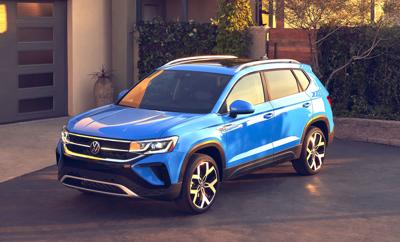You could say the all-new Volkswagen Taos is just a smaller version of the Tiguan, and you would be right.
For a vehicle that is completely fresh, including a new name, the 2022 Taos feels extremely familiar. Everything about it is designed to fit with the Volkswagen family: its squared-off shape, its neatly designed cabin, and especially its zippy driving feel.
To me, the Taos seems like my VW soulmate, the vehicle I feel as if I knew from the moment we met.
Assuming one likes VolkswagenÃÛèÖÊÓƵ contemporary blend of value and spunk, thatÃÛèÖÊÓƵ a good thing.
Every Taos is powered by a 1.5-liter, four-cylinder turbocharged engine. ItÃÛèÖÊÓƵ a modified version of the JettaÃÛèÖÊÓƵ turbo four, and it works remarkably well in the bigger Taos with one exception.
At times during my test, it made lumpy, jerky power at low RPMs, at least in my test example. Most modern engines aim for a smooth, linear, predictable power output, but I struggled to get the Taos to launch smoothly at times, either surging ahead or loafing slowly. Getting the pedal position right was trickier than most new vehicles.
Other than that quibble, the Taos drives remarkably well. Handling is dramatically better than most of its competitors, making it a hoot to drive on winding roads. ItÃÛèÖÊÓƵ almost as fun as the Golf, albeit with a higher center of gravity.
Its eight-speed transmission feels flawless, serving up fast, crisp, seamless shifts at every point in the rev range.
ItÃÛèÖÊÓƵ also remarkably efficient, rated for 28 mpg in city driving and 36 on the highway—very impressive for a vehicle this size. All-wheel drive drops those numbers down to 25 and 32, respectively.
The Taos is designed to slot below the Tiguan in VolkswagenÃÛèÖÊÓƵ SUV lineup, but it looks and feels roughly the same size to me. ItÃÛèÖÊÓƵ a little smaller, if you trust the measurements, but visually it punches above its class.
That might be because some of the lines seem to match the Atlas, VWÃÛèÖÊÓƵ biggest SUV, more than the sprightlier Tiguan. A boxy back end gives it a masculine look and utilitarian space at the same time.
Inside, the Taos will feel instantly familiar to anyone who has driven a VW the past few years. It has the same clean, modern dash layout and easy-to-use buttons.
In a world packed with strong competitors—of which the new Taos is one of many fresh entries—it has to stand out on value, and Volkswagen did a good job living up to the brand promise on this vehicle.
The Taos aims to deliver lots of content for the money at every price point. I thought the equipment on my tester made it seem more expensive than its $33,885 sticker price reflected, including the IQ.DRIVE system with Travel Assist. When you turn that feature on using a button on the steering wheel, the Taos does an outstanding job essentially driving itself on the highway, albeit with the driverÃÛèÖÊÓƵ hands on the wheel and attention on the road.
I also loved the Digital Cockpit on my test Taos, which replaces analog gauges with a customizable digital display behind the steering wheel.
From the cynical, purist, car-guy perspective I gravitate toward, I struggle to love cars such as this. ItÃÛèÖÊÓƵ clearly designed to fill a niche in an increasingly sliced-and-diced world of crossovers and SUVs of every shape and size. I have the same complaint about all its competitors, too, which tend to be derivative and unoriginal.
As a realist and a dad, though, I get it. Vehicles such as this are extremely useful and sell like crazy for a reason.
There are likely plenty of buyers lining up for an ever-so-slightly smaller, more affordable version of the Tiguan. Now itÃÛèÖÊÓƵ here, and itÃÛèÖÊÓƵ named after a picturesque town in New Mexico.
Pricing starts at $22,995 for the Taos S with front-wheel drive, or $25,040 if you opt for all-wheel drive. The SEL trim with all-wheel drive tops the lineup at $33,045.











